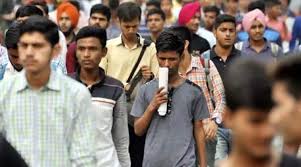Periodic Labour Force Survey (PLFS) Report 06/06/2019 – Posted in: Daily News – Tags: unemployment
PERIODIC LABOUR FORCE SURVEY (PLFS) REPORT
For: Mains
Topic covers: Survey Report, Findings, PLF
News Flash
The report from the Periodic Labour Force Survey (PLFS) is finally out.
Findings
- Unemployment has hit a four-decade high of 6.1 per cent in the country, according to the latest figures released by the Ministry of Statistics and Program Implementation (MoSPI).
- The bad news has reportedly affected urban youth, those aged between 15 and 29 years, the hardest.
- As per the Periodic Labour Force Survey (PLFS) data for 2017-18, nearly a quarter of young urban job seekers remained unemployed during the December quarter.
- After rising steadily for three quarters, the unemployment rate among urban youth hit 23.7 per cent in the third quarter of FY18.
- In current weekly status (CWS), the unemployment rate was “8.8 per cent among males and 12.8 per cent among females in urban areas.
- In the usual status, unemployment rate stood at 7.1 per cent among males and 10.8 per cent among females in urban areas.
- Male youth unemployment rose to 18.7 per cent in FY18 from 8.1 per cent in FY12, when measured by the usual status, while for females it rose to 27.2 per cent from 13.1 per cent in the same period.
- While the unemployment rate has been going up, the labour participation rate – the proportion of the working age population (over 15 years) that is either employed or actively seeking a job – has been falling.
- The LFPR for urban youth in the 15-29 age bracket in FY18 is pegged at 38.5 per cent, down from 40.5 per cent in FY12 as more of them enrolled for higher studies, especially females.
- The pan-India figure for all ages in FY18 stood at 36.9 per cent, down from 39.5 per cent in FY12.
- The double whammy of sliding LFPR and rising unemployment means that India’s employment rate is falling.
- The number of Indian youth fast rising – from 333 million as per Census 2011 this demographic is projected to grow to 370 million by 2031 – the problem of jobless growth will only get exacerbated if remedial steps are not taken post haste.
- Youth unemployment in the December quarter of 2018 was reportedly the highest in Bihar (40.9%), followed by Kerala (37%) and Odisha (35.7%), while it was the lowest in Gujarat (9.6%).
Definition of Unemployment
A person who is unable to get work for even an hour during a reference period of seven days preceding the date of survey, despite seeking employment, is considered unemployed under current weekly status (CWS).
Under usual status, the employment activity of a person is determined on the basis of a reference period of 365 days preceding the date of the survey.
Three Pointer
First, while the unemployment rate is a frequently used measure of poor performance of the economy, under conditions of rising school and college enrolment, it paints an inaccurate picture.
Second, the reported unemployment rate is dominated by the experience of younger Indians who face higher employment challenges and exhibit greater willingness to wait for the right job than their older peers.
Third, the unemployment challenge is greatest for people with secondary or higher education, and rising education levels inflate unemployment challenges.
These three conditions, taken together, suggest that part of India’s unemployment challenge lies in its success in expanding education while not expanding formal sector jobs
Periodic Labour Force Survey (PLFS)
- PLFS was launched with the objective of measuring employment every three months in urban areas and once a year in both rural and urban areas.
- The survey uses education levels as a criterion for stratification at the ultimate level.
- The logic behind this decision was that the education levels in the economy have risen due to this various policy interventions such as the Right to Education Act, and it would be important to assess the level of employment and unemployment using this benchmark.
Source: Business Today
You can follow us on LinkedIn and for more updates related to UPSC IAS Preparation, Like our Facebook Page and subscribe our Diligent IAS Youtube Channel

